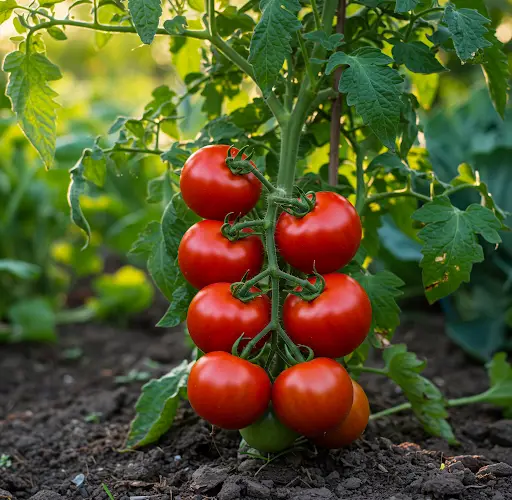How to Protect Tomato Plants from Heat and Boost Their Health Naturally
Tomatoes are a favorite crop for many gardeners due to their versatility, taste, and nutritional value. While tomatoes thrive in warm climates, they are particularly vulnerable to high temperatures and intense sun exposure. Extreme heat can significantly affect their growth, development, and overall yield. Understanding how to protect tomatoes from heat stress and how to support their resilience with natural feeding methods is essential for successful cultivation.
Why Tomatoes Need Protection from Heat
Tomatoes are tropical plants that love sunshine and warmth. However, when temperatures climb above 30°C (86°F), their growth can be negatively impacted. Here are some of the key issues associated with excessive heat:
-
Sunscald and Fruit Burn: High temperatures combined with direct sunlight can cause sunscald—burn-like spots on the fruit—leading to uneven ripening, poor appearance, and reduced market value.
-
Impaired Photosynthesis: Photosynthesis slows down in extreme heat, limiting the plant’s ability to produce energy, which in turn stunts growth and decreases productivity.
-
Flower Drop: One of the most critical problems is flower drop. When stressed by heat, tomato plants often abort their flowers before they can set fruit, resulting in fewer tomatoes.
-
Weakened Plants: Continuous exposure to heat stress can weaken tomato plants, making them more susceptible to diseases and insect infestations.
Effective Strategies to Protect Tomatoes from Heat
Preventing heat damage requires a combination of practical gardening techniques. These methods help maintain ideal growing conditions and protect the plant from temperature extremes.
-
Watering Wisely
Watering is crucial, especially during hot weather. Tomatoes should be watered deeply and consistently, preferably early in the morning before temperatures rise. This ensures the plants are well-hydrated throughout the hottest part of the day and helps prevent wilting and stress. -
Mulching
Applying a layer of organic mulch around the base of the plants helps retain soil moisture and insulate the roots from heat. Straw, grass clippings, and shredded leaves are all excellent mulch options. Mulching also reduces weed competition and improves soil structure over time. -
Providing Shade
Shade netting or lightweight garden fabric can be used to filter sunlight and reduce heat exposure during the hottest hours of the day. Even partial shading can lower leaf temperature and prevent sunscald without significantly affecting photosynthesis. -
Improving Soil Structure
Incorporating organic material into the soil—such as compost or aged manure—enhances its ability to retain water and nutrients. Healthy, well-drained soil provides a buffer against temperature extremes and promotes strong root development.
A Natural Homemade Recipe to Boost Tomato Resilience
In addition to physical protection, feeding tomatoes with natural supplements can enhance their vitality and resistance to stress. A powerful homemade tonic made from dry yeast, turmeric, and baking soda has shown beneficial effects on plant health.
Ingredients:
-
1 tablespoon dry yeast
-
1 teaspoon turmeric powder
-
1 teaspoon baking soda
-
1 liter of water (for mixing)
-
5 liters of additional water (for dilution)
Preparation:
-
Mix the dry yeast, turmeric, and baking soda into 1 liter of lukewarm water.
-
Stir thoroughly and let the mixture stand for approximately 2 hours.
-
After the solution has rested, dilute it with 5 liters of water before use.
Application:
-
Water tomato plants with the diluted mixture every two weeks.
-
For added protection against fungal diseases, the solution can be sprayed directly onto the leaves once a week.
Benefits of the Natural Ingredients
-
Dry Yeast: Rich in vitamins and beneficial hormones, yeast stimulates microbial activity in the soil and supports lush foliage growth. It also helps strengthen the plant overall, reducing leaf tip drying and improving vigor.
-
Turmeric: Known for its antiseptic and antifungal properties, turmeric acts as a natural defense against various plant diseases. It supports overall health by limiting fungal infections in the soil and on the leaves.
-
Baking Soda: Helps neutralize soil acidity and create an unfavorable environment for fungal diseases like downy mildew. Its application can improve the soil’s pH balance, which is ideal for tomato plants that prefer slightly acidic to neutral soil.
Final Thoughts
Protecting tomatoes from heat stress is essential for a productive and healthy garden. By combining smart cultural practices—like mulching, shading, and proper watering—with natural, nutrient-rich feeding, gardeners can ensure their tomato plants remain strong, healthy, and fruitful, even during the hottest months. Using these strategies not only reduces reliance on synthetic chemicals but also promotes a more sustainable and eco-friendly approach to gardening.



